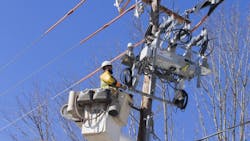PPL Electric Utilities Introduces Automated Power Restoration System
A new automated power restoration system is turning the lights back on for PPL Electric Utilities customers in minutes, even before a work crew has made repairs.
The system led to significantly shorter power outages for thousands of homes and businesses in two recent rounds of thunderstorms.
The PPL smart grid uses advanced technology that includes pole-top sensors to detect outages, a central computer that quickly analyzes the problem, and remote-control switches that reroute power and restore many affected customers to service.
"Our goal is to provide exceptional service for our customers, and this new technology is one key way we are doing that," said David Quier, the utility's operations director.
During severe thunderstorms the week of July 18, the PPL smart grid restored 9,488 homes and businesses to service in an average of one minute and 56 seconds. The following week, during another round of severe storms, the technology restored 5,308 customers automatically in an average of one minute and 36 seconds.
Automated power restoration is the latest in a series of reliability improvements made by PPL. Other ways the company is improving service for customers include making lines and equipment more stormproof, installing guards to keep squirrels and other animals from causing outages, and expanded tree trimming, because trees are the major cause of outages during storms.
The result has been a 30 percent reduction in the number of power outages since 2007, with another 15 percent fewer outages expected in the next five years. During 2015, PPL Electric Utilities reliability programs prevented an estimated 410,000 power outages for customers.
Here is how the smart grid system works:
A car striking a pole might trip a circuit breaker and knock out power for all customers in the neighborhood. Smart grid technology instantly detects the outage, throws switches to isolate the damaged area from the rest of the circuit, and then reroutes power to restore service to many of the affected customers. A work crew then responds to install a new pole, turning the lights back on for those customers who could not be restored automatically because they were closest to the damage.
Here are some recent examples of smart grid operations:
- A tree branch fell on a power line in Thompsontown, Juniata County, on April 9, cutting power to 1,800 customers. The PPL smart grid returned 1,016 of the customers to service in four minutes.
- A tree fell on a power line in the Macungie area on June 24, cutting power to 1,758 customers. In two minutes, 923 of the customers were returned to service.
- A storm in the Bloomsburg area June 28 cut power to 1,694 customers. In four minutes, smart grid had turned power back on for 1,456 customers.
- An equipment failure in the Whitehall area June 28 cut power to 1,578 customers. In two minutes, 856 of the customers were back in power.
"In the coming years, we will install another 1,000 smart grid sensors and automated switches around PPL's service territory," Quier said. "This will make the PPL smart grid system even more effective, further improving the reliability of our service for customers."
